Schools turn underused spaces into tinkering hubs, edible gardens thanks to MOE grant
Sign up now: Get ST's newsletters delivered to your inbox
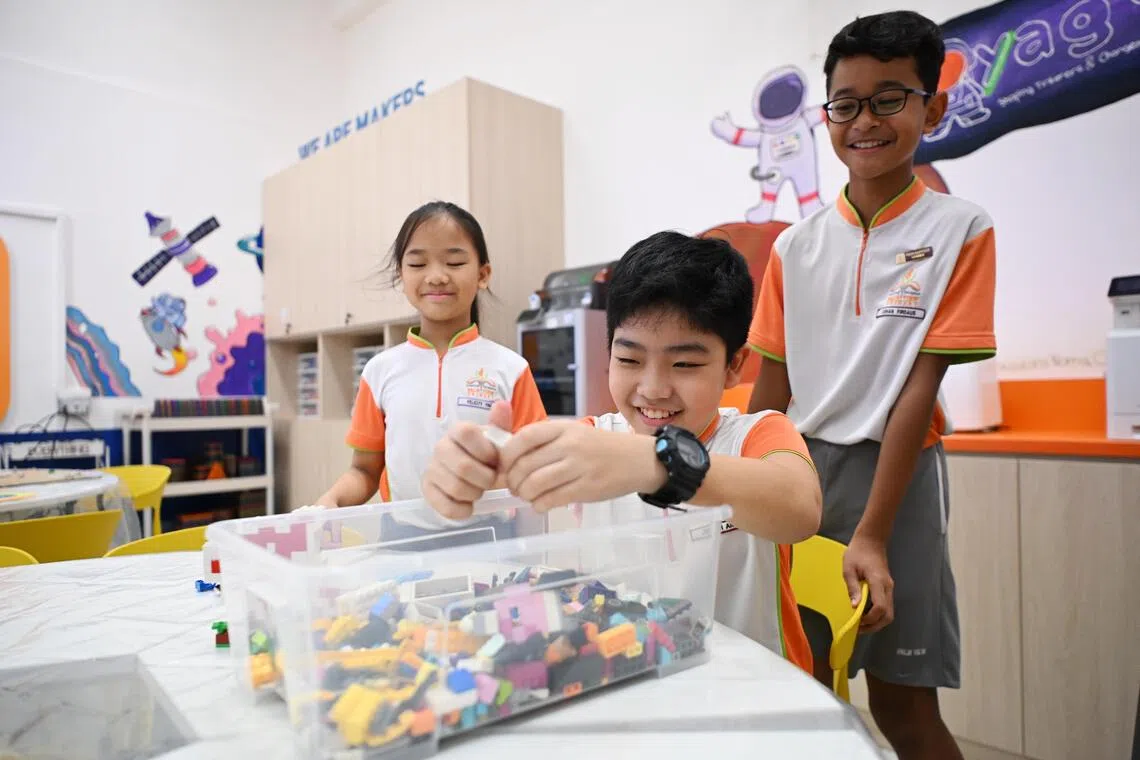
(From left) Palm View Primary School pupils Felicity Ying, Jeriah Ang, and Eshan Firdaus using the Lego bricks at the makerspace on Oct 23, 2025.
ST PHOTO: AZMI ATHNI
Follow topic:
SINGAPORE – Schools in Singapore have converted underutilised spaces into living classrooms and tinkering hubs, with the help of the Ministry of Education’s (MOE) School White Area and Canteen Grant.
Introduced in April 2024, the $64 million grant
In response to queries, MOE said about 110 schools have tapped the grant to implement enhancements as at end-June 2025.
With allocated funding per school ranging from $170,000 to $270,000, schools have created areas such as makerspaces, environment hubs and student collaboration spaces.
Along with the grant in 2024, MOE has also provided additional funding for schools to buy new furniture and equipment.
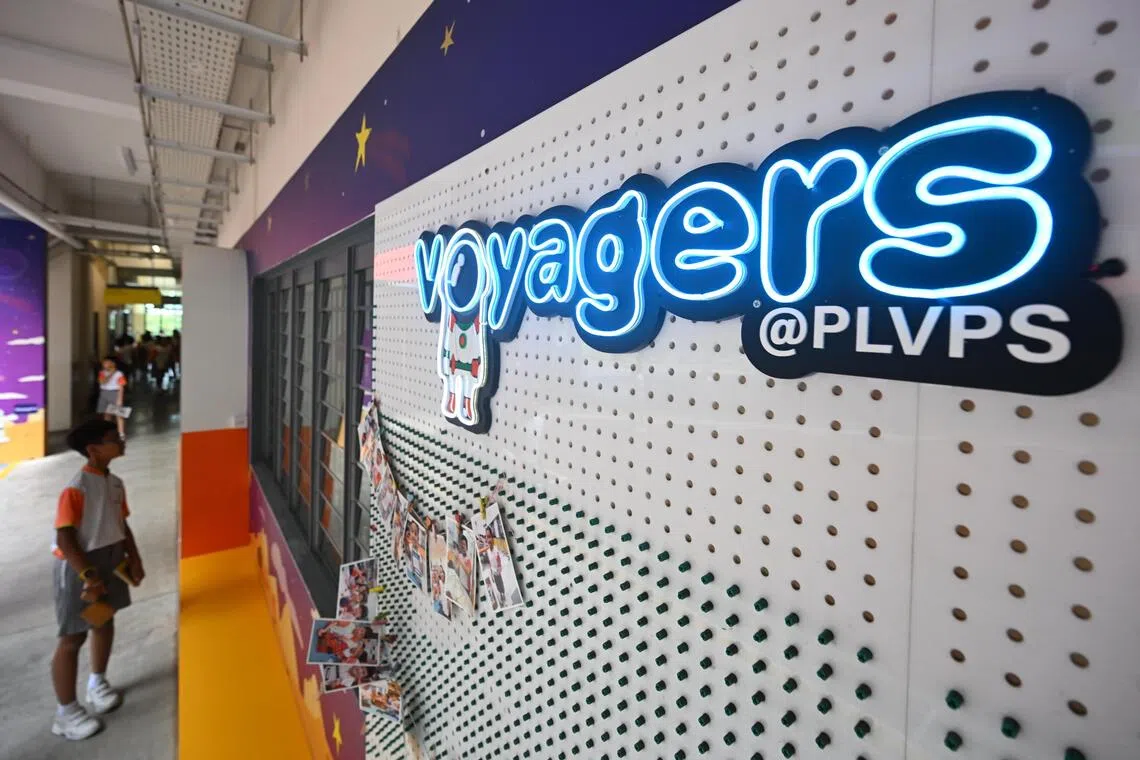
Inside Palm View Primary School’s makerspace, pupils have access to tools that allow them to bring their design ideas to life.
ST PHOTO: AZMI ATHNI
“Schools have the flexibility to decide how best to use these additional funds to refresh their learning spaces – such as by acquiring mobile furniture, LED display panels or magnetic whiteboards – to support a wider range of learning approaches and programmes,” said MOE.
Space to tinker and create at Palm View Primary
Recess time at Palm View Primary in Sengkang usually consisted of pupils gobbling down their meals and snacks before darting off to the field or playground for play.
Since August 2025, pupils have been using their recess time to play, not under the sun, but in a makerspace filled with tools they can use to bring their design ideas to life.
What was once an underutilised art room on the first floor is now a launchpad for experimentation and creative thinking, where pupils have access to various tools and educational toys.
These include 3D pens and printers; micro:bit, a pocket-size programmable computer; Lego bricks; Strawbees, an educational toy made of plastic straws and connectors; and magnetic tiles.
The school’s principal, Mrs Ming Kum, said she envisioned the space as a place where the pupils can enjoy their childhood away from academic rigour and screens.
“As digital natives, they are exposed a lot to devices and do not have enough opportunities to use their hands to really create things from scratch... So we want them to use this space to channel their energy and creativity to building, and just experiencing the joy of freedom of expression,” she said.
The school used $25,000 from the School White Area and Canteen Grant to transform the former art room by installing built-in cupboards, customised worktop tables, pull-out drawers and decorative features.
Construction took place from May to July 2025. Though the space was officially launched in September, pupils eager to use it could do so a month earlier.
To ensure that pupils use the tools purposefully, the school came up with an ideation card, which students have to complete before being allowed into the makerspace.
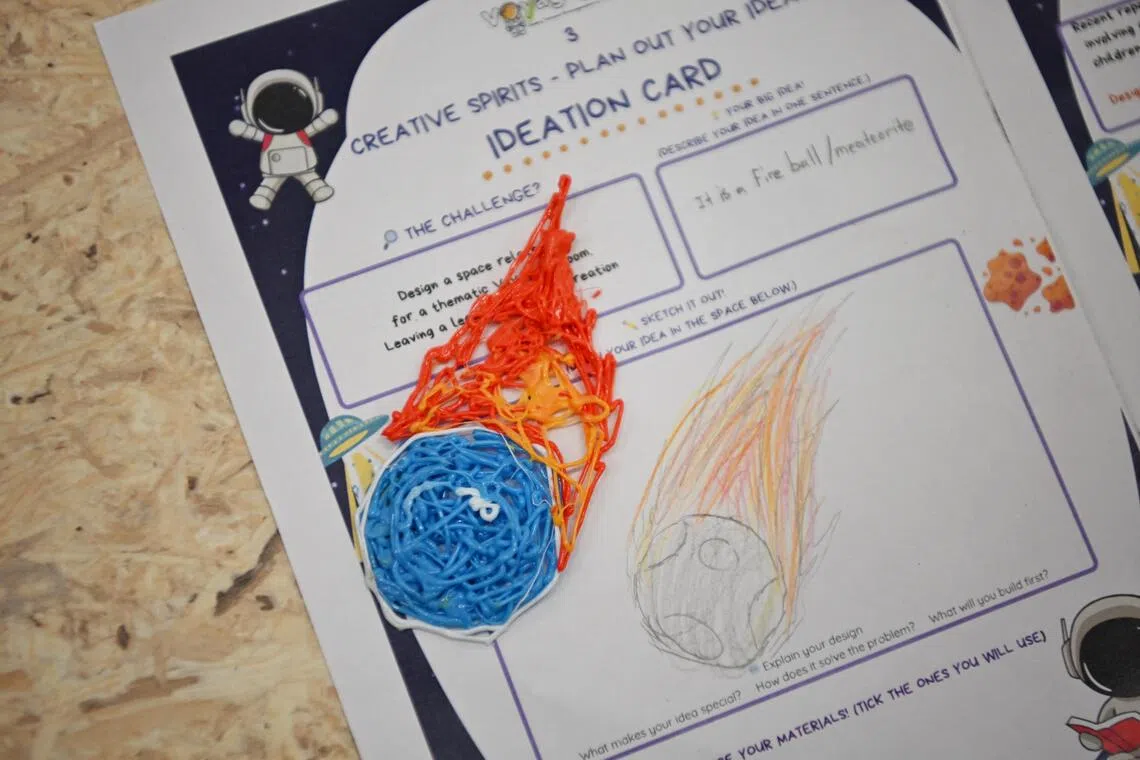
An ideation card used by Palm View Primary School pupils at the makerspace.
ST PHOTO: AZMI ATHNI
Parent volunteers who help manage the space during recess will check that pupils, having indicated what they intend to create and what material they will use, provide a drawing of what the final product will look like.
Mr Warren Thin, Palm View Primary’s head of information and communications technology, said the card is an entry ticket of sorts, which also helps parent volunteers to better supervise the activities in the makerspace.
“This way, pupils then come into the space with a purpose, and they’re very focused on the materials that they use and what they want to do with them,” he said.
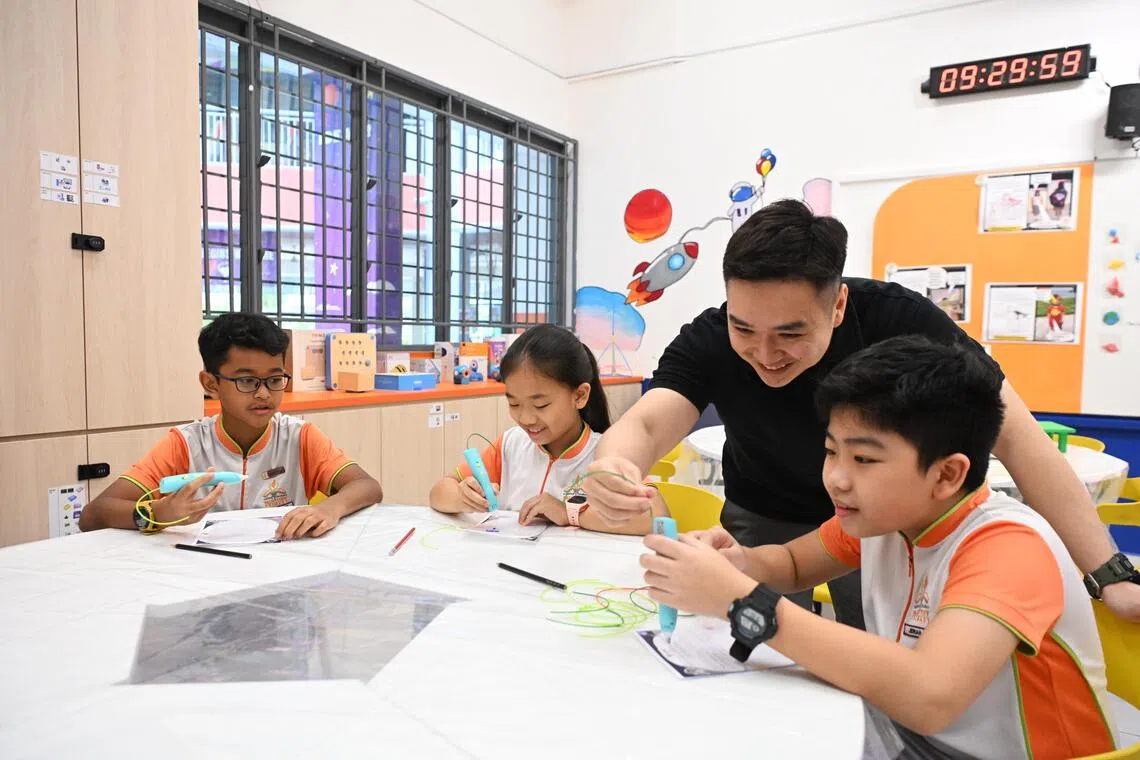
Mr Warren Thin, head of ICT at Palm View Primary School, guiding pupils (from left) Eshan Firdaus, Felicity Ying and Jeriah Ang at the makerspace on Oct 23.
ST PHOTO: AZMI ATHNI
Primary 5 pupils Eshan Firdaus Selemat and Jeriah Ang told The Straits Times that even though long queues form outside the makerspace, they are always eager to visit the space when it is open.
“Here, we have the chance to think of ways to build using our imagination, and we learn how to improvise and problem-solve on our own,” said Eshan, adding that time spent there is a good respite from sweating it out on the playground or field.
His classmate, Jeriah, encourages others to join them at the makerspace during recess so as to spend time together. He added that since the space can accommodate about 25 pupils at a time, they learn to communicate with one another to share the limited resources available.
“If someone takes a Lego piece that you need, then you can’t build what you want. So it’s good to work together to build a big one, so that everybody has a role and is included,” said Jeriah.
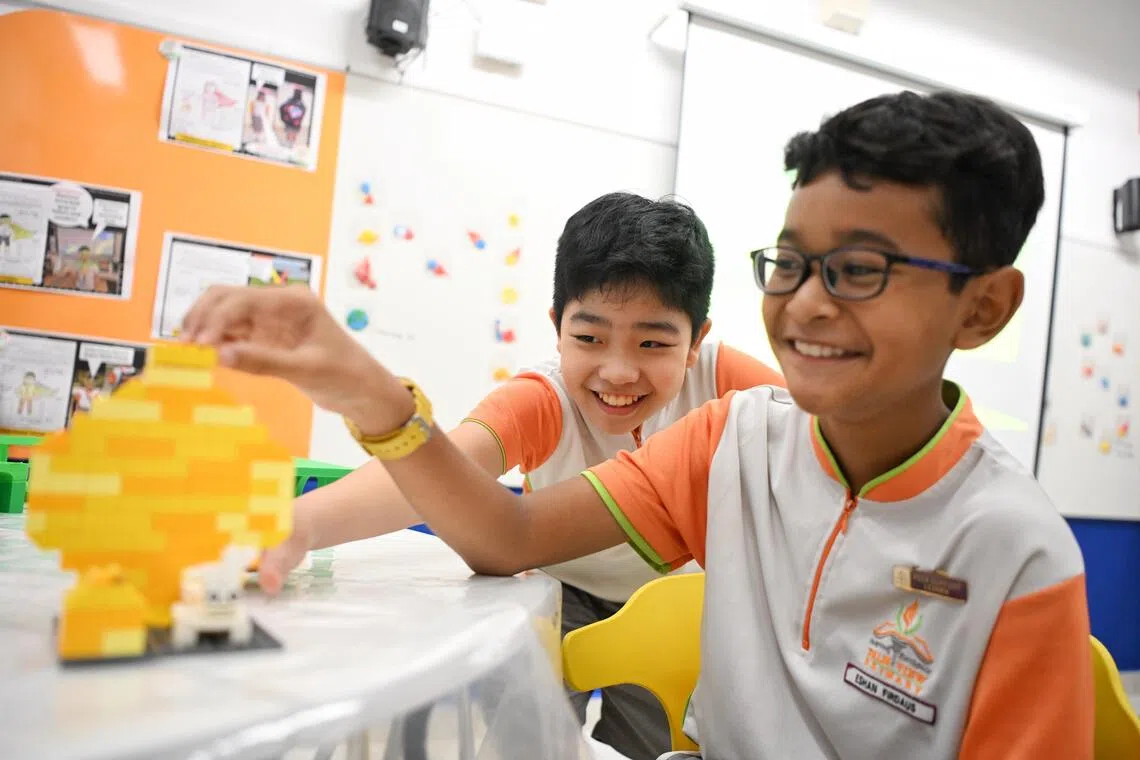
Primary 5 pupils Jeriah Ang (left) and Eshan Firdaus Selemat building a display for the Mid-Autumn Festival using Lego bricks at the makerspace on Oct 23. ST PHOTO: AZMI ATHNI
The Straits Times
From grass patch to living classroom and edible garden
At Greendale Secondary School in Punggol, a 1,200 sq ft grass patch – the size of a small flat – has been transformed into a living classroom and edible community garden for students and staff to enjoy.
Construction began in August 2024 and took about four months to complete. The garden, officially opened in January 2025, is now used by the school in various ways.
For example, students visit to observe leaf structures and flowers up close and to study factors that affect plant growth. They also learn about sustainable gardening practices and nutrition, while harvested crops are donated to the community as a form of engagement.
Geography students use the space to understand why a variety of crops is needed for food security and how biodiversity exists in tropical rainforests.
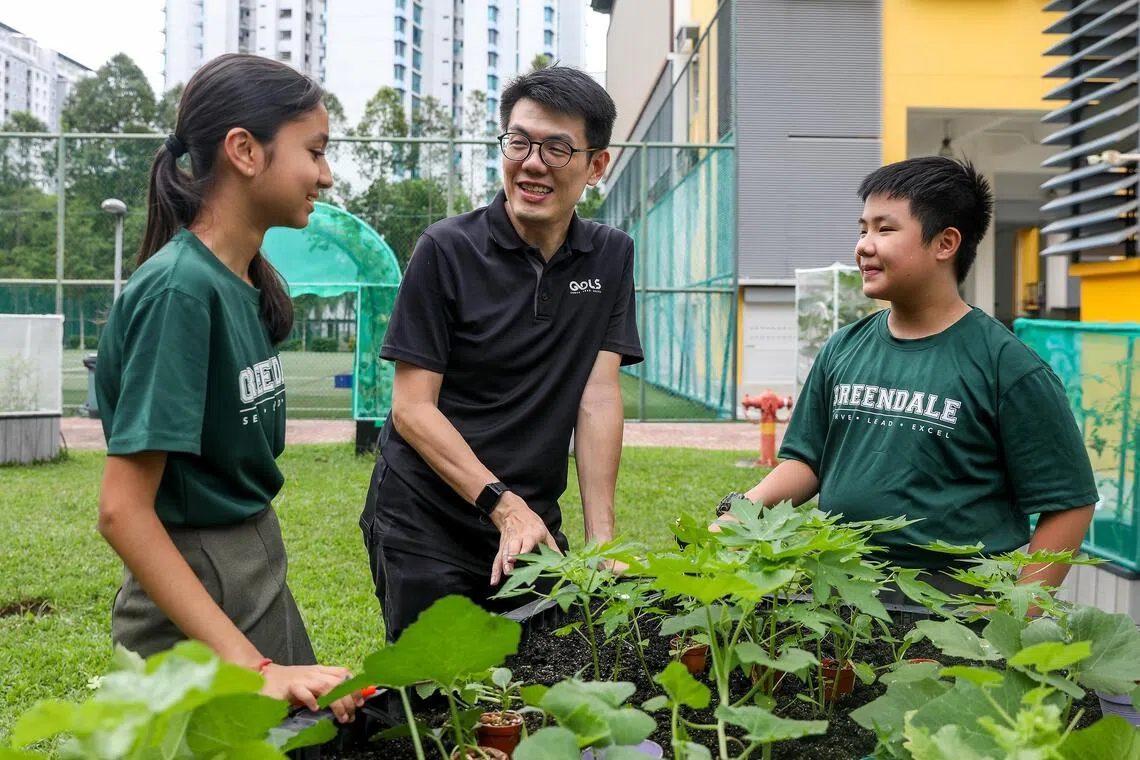
Greendale Secondary School’s edible community garden serves as a living classroom for students.
ST PHOTO: LUTHER LAU
Mr William Teng, who is on the school’s sustainability committee and oversaw the conceptualisation of the space, said a team was assembled to design an outdoor garden that supports authentic and experiential learning. “So the goal was to create a living classroom where students can connect subject knowledge with real-world applications, thereby developing critical and inventive thinking and collaboration skills.”
The school used $20,000 from the MOE grant for this.
Students and staff can also adopt planters to nurture crops such as pumpkins, butterfly pea flowers and broccoli.
Sec 2 student Aanya Agarwal, 14, a member of the school’s Green Club and an avid gardener, said she enjoys taking care of the plants in the edible community garden as it allows her to learn and spend time outside the classroom.
“It’s very peaceful and different from being in a classroom... I like to see how plants grow from small seeds into big plants, and I like to get my hands dirty,” said Aanya, who also grows basil and tomatoes at home.

Green Club members Aanya Agarwal and Jayden Tan tending to plants in the edible community garden at Greendale Secondary School.
ST PHOTO: LUTHER LAU
Fellow Green Club member and Sec 1 student Jayden Tan, 13, said that though he is new to gardening, he always encourages his friends to visit the edible community garden to see biodiversity come alive.
“There's a lot to see, like spiders and snails. Sometimes, if I dig in the soil, I can find worms as well. Overall, it’s very peaceful and relaxing. It’s a great place for me to take my mind off things.”


